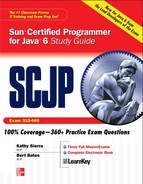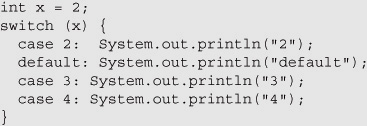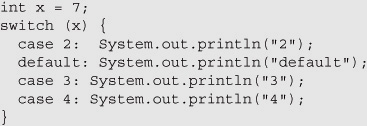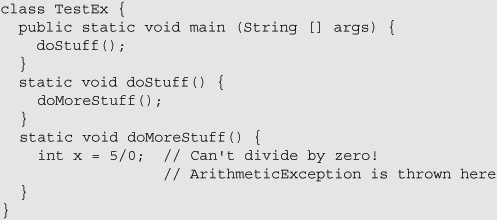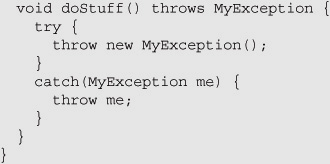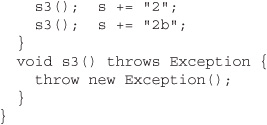5
Flow Control, Exceptions, and Assertions
CERTIFICATION OBJECTIVES
![]() Use if and switch Statements
Use if and switch Statements
![]() Develop for, do, and while Loops Use break and continue Statements
Develop for, do, and while Loops Use break and continue Statements
![]() Develop Code with Assertions
Develop Code with Assertions
![]() Use try, catch, and finally Statements
Use try, catch, and finally Statements
![]() State the Effects of Exceptions
State the Effects of Exceptions
![]() Recognize Common Exceptions
Recognize Common Exceptions
![]() Two-Minute Drill
Two-Minute Drill
Q&A Self Test
Can you imagine trying to write code using a language that didn't give you a way to execute statements conditionally? Flow control is a key part of most any useful programming language, and Java offers several ways to do it. Some, like if statements and for loops, are common to most languages. But Java also throws in a couple of flow control features you might not have used before—exceptions and assertions.
The if statement and the switch statement are types of conditional/decision controls that allow your program to behave differently at a "fork in the road," depending on the result of a logical test. Java also provides three different looping constructs—for, while, and do—so you can execute the same code over and over again depending on some condition being true. Exceptions give you a clean, simple way to organize code that deals with problems that might crop up at runtime. Finally, the assertion mechanism, added to the language with version 1.4, gives you a way to do testing and debugging checks on conditions you expect to smoke out while developing, when you don't necessarily need or want the runtime overhead associated with exception handling.
With these tools, you can build a robust program that can handle any logical situation with grace. Expect to see a wide range of questions on the exam that include flow control as part of the question code, even on questions that aren't testing your knowledge of flow control.
CERTIFICATION OBJECTIVE
if and switch Statements (Exam Objective 2.1)
2.1 Develop code that implements an if or switch statement; and identify legal argument types for these statements.
The if and switch statements are commonly referred to as decision statements. When you use decision statements in your program, you're asking the program to evaluate a given expression to determine which course of action to take. We'll look at the if statement first.
if-else Branching
The basic format of an if statement is as follows:

The expression in parentheses must evaluate to (a boolean) true or false. Typically you're testing something to see if it's true, and then running a code block (one or more statements) if it is true, and (optionally) another block of code if it isn't. The following code demonstrates a legal if-else statement:

The else block is optional, so you can also use the following:

The preceding code will assign 2 to y if the test succeeds (meaning x really is greater than 3), but the other two lines will execute regardless. Even the curly braces are optional if you have only one statement to execute within the body of the conditional block. The following code example is legal (although not recommended for readability):

Sun considers it good practice to enclose blocks within curly braces, even if there's only one statement in the block. Be careful with code like the above, because you might think it should read as,
"If x is greater than 3, then set y to 2, z to z + 8, and a to y + x."
But the last two lines are going to execute no matter what! They aren't part of the conditional flow. You might find it even more misleading if the code were indented as follows:

You might have a need to nest if-else statements (although, again, it's not recommended for readability, so nested if tests should be kept to a minimum). You can set up an if-else statement to test for multiple conditions. The following example uses two conditions so that if the first test fails, we want to perform a second test before deciding what to do:
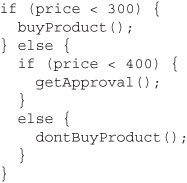
This brings up the other if-else construct, the if, else if, else. The preceding code could (and should) be rewritten:
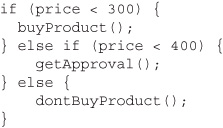
There are a couple of rules for using else and else if:
![]() You can have zero or one else for a given if, and it must come after any else ifs.
You can have zero or one else for a given if, and it must come after any else ifs.
![]() You can have zero to many else ifs for a given if and they must come before the (optional) else.
You can have zero to many else ifs for a given if and they must come before the (optional) else.
![]() Once an else if succeeds, none of the remaining else ifs or elses will be tested.
Once an else if succeeds, none of the remaining else ifs or elses will be tested.
The following example shows code that is horribly formatted for the real world. As you've probably guessed, it's fairly likely that you'll encounter formatting like this on the exam. In any case, the code demonstrates the use of multiple else ifs:

It produces the output:
<4
(Notice that even though the second else if is true, it is never reached.) Sometimes you can have a problem figuring out which if your else should pair with, as follows:

We intentionally left out the indenting in this piece of code so it doesn't give clues as to which if statement the else belongs to. Did you figure it out? Java law decrees that an else clause belongs to the innermost if statement to which it might possibly belong (in other words, the closest preceding if that doesn't have an else). In the case of the preceding example, the else belongs to the second if statement in the listing. With proper indenting, it would look like this:

Following our coding conventions by using curly braces, it would be even easier to read:
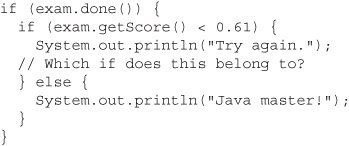
Don't get your hopes up about the exam questions being all nice and indented properly. Some exam takers even have a slogan for the way questions are presented on the exam: anything that can be made more confusing, will be.
Be prepared for questions that not only fail to indent nicely, but intentionally indent in a misleading way: Pay close attention for misdirection like the following:

Of course, the preceding code is exactly the same as the previous two examples, except for the way it looks.
Legal expressions for if statements
The expression in an if statement must be a boolean expression. Any expression that resolves to a boolean is fine, and some of the expressions can be complex. Assume doStuff() returns true,
![]()
which prints
true
You can read the preceding code as, "If both (x > 3) and (y < 2) are true, or if the result of doStuff() is true, then print true." So basically, if just doStuff() alone is true, we'll still get true. If doStuff() is false, though, then both (x > 3) and (y < 2) will have to be true in order to print true. The preceding code is even more complex if you leave off one set of parentheses as follows,

which now prints…nothing! Because the preceding code (with one less set of parentheses) evaluates as though you were saying, "If (x > 3) is true, and either (y < 2) or the result of doStuff() is true, then print true." So if (x > 3) is not true, no point in looking at the rest of the expression." Because of the short-circuit &&, the expression is evaluated as though there were parentheses around (y < 2) | doStuff(). In other words, it is evaluated as a single expression before the && and a single expression after the &&.
Remember that the only legal expression in an if test is a boolean. In some languages, 0 == false, and 1 == true. Not so in Java! The following code shows if statements that might look tempting, but are illegal, followed by legal substitutions:

|
|
One common mistake programmers make (and that can be difficult to spot), is assigning a boolean variable when you meant to test a boolean variable. Look out for code like the following: |
|
|
|
|
|
You might think one of three things: |
|
1. The code compiles and runs fine, and the if test fails because boo is false. |
|
2. The code won't compile because you're using an assignment ( = )rather than an equality test ( == ). |
|
3. The code compiles and runs fine and the if test succeeds because boo is SET to true (rather than TESTED for true ) in the if argument! |
|
Well, number 3 is correct. Pointless, but correct. Given that the result of any assignment is the value of the variable after the assignment, the expression ( boo = true ) has a result of true . Hence, the if test succeeds. But the only variables that can be assigned (rather than tested against something else) are a boolean or a Boolean ; all other assignments will result in something non-boolean, so they're not legal, as in the following: |
|
|
|
Because if tests require boolean expressions, you need to be really solid on both logical operators and if test syntax and semantics. |
switch Statements
A way to simulate the use of multiple if statements is with the switch statement. Take a look at the following if-else code, and notice how confusing it can be to have nested if tests, even just a few levels deep:
![]()
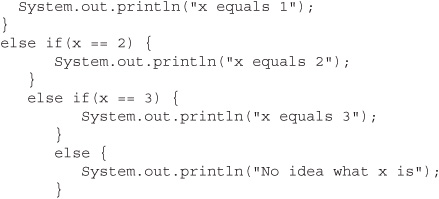
Now let's see the same functionality represented in a switch construct:
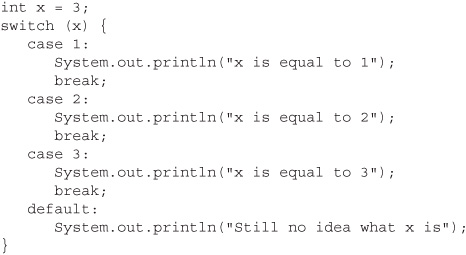
Note: The reason this switch statement emulates the nested ifs listed earlier is because of the break statements that were placed inside of the switch. In general, break statements are optional, and as we will see in a few pages, their inclusion or exclusion causes huge changes in how a switch statement will execute.
Legal expressions for switch and case
The general form of the switch statement is:

A switch's expression must evaluate to a char, byte, short, int, or, as of Java 6, an enum. That means if you're not using an enum, only variables and values that can be automatically promoted (in other words, implicitly cast) to an int are acceptable. You won't be able to compile if you use anything else, including the remaining numeric types of long, float, and double.
A case constant must evaluate to the same type as the switch expression can use, with one additional—and big—constraint: the case constant must be a compile time constant! Since the case argument has to be resolved at compile time, that means you can use only a constant or final variable that is assigned a literal value. It is not enough to be final, it must be a compile time constant. For example:
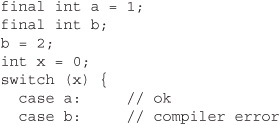
Also, the switch can only check for equality. This means that the other relational operators such as greater than are rendered unusable in a case. The following is an example of a valid expression using a method invocation in a switch statement. Note that for this code to be legal, the method being invoked on the object reference must return a value compatible with an int.

One other rule you might not expect involves the question, "What happens if I switch on a variable smaller than an int?" Look at the following switch:

This code won't compile. Although the switch argument is legal—a byte is implicitly cast to an int—the second case argument (128) is too large for a byte, and the compiler knows it! Attempting to compile the preceding example gives you an error something like

It's also illegal to have more than one case label using the same value. For example, the following block of code won't compile because it uses two cases with the same value of 80:

It is legal to leverage the power of boxing in a switch expression. For instance, the following is legal:

|
|
Look for any violation of the rules for switch and case arguments. For example, you might find illegal examples like the following snippets: |
|
|
|
|
|
In the first example, the case uses a curly brace and omits the colon. The second example omits the keyword case. |
Break and Fall-Through in switch Blocks
We're finally ready to discuss the break statement, and more details about flow control within a switch statement. The most important thing to remember about the flow of execution through a switch statement is this:
case constants are evaluated from the top down, and the first case constant that matches the switch 's expression is the execution entry point.
In other words, once a case constant is matched, the JVM will execute the associated code block, and ALL subsequent code blocks (barring a break statement) too! The following example uses an enum in a case statement.

In this example case green: matched, so the JVM executed that code block and all subsequent code blocks to produce the output:
![]()
Again, when the program encounters the keyword break during the execution of a switch statement, execution will immediately move out of the switch block to the next statement after the switch. If break is omitted, the program just keeps executing the remaining case blocks until either a break is found or the switch statement ends. Examine the following code:

The code will print the following:

This combination occurs because the code didn't hit a break statement; execution just kept dropping down through each case until the end. This dropping down is actually called "fall-through," because of the way execution falls from one case to the next. Remember, the matching case is simply your entry point into the switch block! In other words, you must not think of it as, "Find the matching case, execute just that code, and get out." That's not how it works. If you do want that "just the matching code" behavior, you'll insert a break into each case as follows:
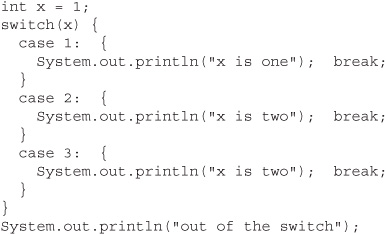
Running the preceding code, now that we've added the break statements, will print
![]()
and that's it. We entered into the switch block at case 1. Because it matched the switch() argument, we got the println statement, then hit the break and jumped to the end of the switch.
An interesting example of this fall-through logic is shown in the following code:
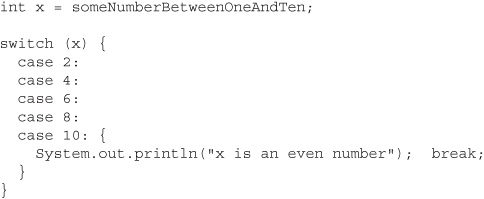
This switch statement will print x is an even number or nothing, depending on whether the number is between one and ten and is odd or even. For example, if x is 4, execution will begin at case 4, but then fall down through 6, 8, and 10, where it prints and then breaks. The break at case 10, by the way, is not needed; we're already at the end of the switch anyway.
Note: Because fall-through is less than intuitive, Sun recommends that you add a comment like: // fall through when you use fall-through logic.
The Default Case
What if, using the preceding code, you wanted to print "x is an odd number" if none of the cases (the even numbers) matched? You couldn't put it after the switch statement, or even as the last case in the switch, because in both of those situations it would always print x is an odd number. To get this behavior, you'll use the default keyword. (By the way, if you've wondered why there is a default keyword even though we don't use a modifier for default access control, now you'll see that the default keyword is used for a completely different purpose.) The only change we need to make is to add the default case to the preceding code:
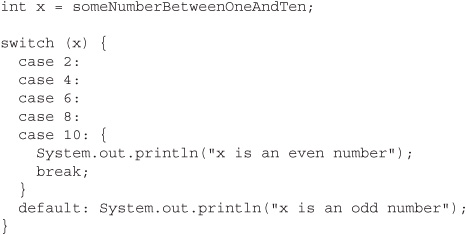
|
|
The default case doesn't have to come at the end of the switch . Look for it in strange places such as the following: |
|
|
|
|
EXERCISE 5-1
Creating a switch-case Statement
Try creating a switch statement using a char value as the case. Include a default behavior if none of the char values match.
![]() Make sure a char variable is declared before the switch statement.
Make sure a char variable is declared before the switch statement.
![]() Each case statement should be followed by a break.
Each case statement should be followed by a break.
![]() The default case can be located at the end, middle, or top.
The default case can be located at the end, middle, or top.
CERTIFICATION OBJECTIVE
Loops and Iterators (Exam Objective 2.2)
2.2 Develop code that implements all forms of loops and iterators, including the use of for, the enhanced for loop (for-each), do, while, labels, break, and continue; and explain the values taken by loop counter variables during and after loop execution.
Java loops come in three flavors: while, do, and for (and as of Java 6, the for loop has two variations). All three let you repeat a block of code as long as some condition is true, or for a specific number of iterations. You're probably familiar with loops from other languages, so even if you're somewhat new to Java, these won't be a problem to learn.
Using while Loops
The while loop is good for scenarios where you don't know how many times a block or statement should repeat, but you want to continue looping as long as some condition is true. A while statement looks like this:
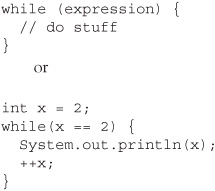
In this case, as in all loops, the expression (test) must evaluate to a boolean result. The body of the while loop will only execute if the expression (sometimes called the "condition") results in a value of true. Once inside the loop, the loop body will repeat until the condition is no longer met because it evaluates to false. In the previous example, program control will enter the loop body because x is equal to 2. However, x is incremented in the loop, so when the condition is checked again it will evaluate to false and exit the loop.
Any variables used in the expression of a while loop must be declared before the expression is evaluated. In other words, you can't say
![]()
Then again, why would you? Instead of testing the variable, you'd be declaring and initializing it, so it would always have the exact same value. Not much of a test condition!
The key point to remember about a while loop is that it might not ever run. If the test expression is false the first time the while expression is checked, the loop body will be skipped and the program will begin executing at the first statement after the while loop. Look at the following example:

Running this code produces
![]()
Because the expression (x > 8) evaluates to false, none of the code within the while loop ever executes.
Using do Loops
The do loop is similar to the while loop, except that the expression is not evaluated until after the do loop's code is executed. Therefore the code in a do loop is guaranteed to execute at least once. The following shows a do loop in action:

The System.out.println() statement will print once, even though the expression evaluates to false. Remember, the do loop will always run the code in the loop body at least once. Be sure to note the use of the semicolon at the end of the while expression.
|
|
As with if tests, look for while loops (and the while test in a do loop) with an expression that does not resolve to a boolean . Take a look at the following examples of legal and illegal while expressions: |
|
|
Using for Loops
As of Java 6, the for loop took on a second structure. We'll call the old style of for loop the "basic for loop", and we'll call the new style of for loop the "enhanced for loop" (even though the Sun objective 2.2 refers to it as the for-each). Depending on what documentation you use (Sun's included), you'll see both terms, along with for-in. The terms for-in, for-each, and "enhanced for" all refer to the same Java construct.
The basic for loop is more flexible than the enhanced for loop, but the enhanced for loop was designed to make iterating through arrays and collections easier to code.
The Basic for Loop
The for loop is especially useful for flow control when you already know how many times you need to execute the statements in the loop's block. The for loop declaration has three main parts, besides the body of the loop:
![]() Declaration and initialization of variables
Declaration and initialization of variables
![]() The boolean expression (conditional test)
The boolean expression (conditional test)
![]() The iteration expression
The iteration expression
The three for declaration parts are separated by semicolons. The following two examples demonstrate the for loop. The first example shows the parts of a for loop in a pseudocode form, and the second shows a typical example of a for loop.

The Basic for Loop: Declaration and initialization
The first part of the for statement lets you declare and initialize zero, one, or multiple variables of the same type inside the parentheses after the for keyword. If you declare more than one variable of the same type, then you'll need to separate them with commas as follows:
![]()
The declaration and initialization happens before anything else in a for loop. And whereas the other two parts—the boolean test and the iteration expression—will run with each iteration of the loop, the declaration and initialization happens just once, at the very beginning. You also must know that the scope of variables declared in the for loop ends with the for loop! The following demonstrates this:

If you try to compile this, you'll get something like this:

Basic for Loop: Conditional (boolean) Expression
The next section that executes is the conditional expression, which (like all other conditional tests) must evaluate to a boolean value. You can have only one logical expression, but it can be very complex. Look out for code that uses logical expressions like this:
![]()
The preceding code is legal, but the following is not:
![]()
The compiler will let you know the problem:
![]()
The rule to remember is this: You can have only one test expression.
In other words, you can't use multiple tests separated by commas, even though the other two parts of a for statement can have multiple parts.
Basic for Loop: Iteration Expression
After each execution of the body of the for loop, the iteration expression is executed. This is where you get to say what you want to happen with each iteration of the loop. Remember that it always happens after the loop body runs! Look at the following:

The preceding loop executes just once. The first time into the loop x is set to 0, then x is tested to see if it's less than 1 (which it is), and then the body of the loop executes. After the body of the loop runs, the iteration expression runs, incrementing x by 1. Next, the conditional test is checked, and since the result is now false, execution jumps to below the for loop and continues on.
Keep in mind that barring a forced exit, evaluating the iteration expression and then evaluating the conditional expression are always the last two things that happen in a for loop!
Examples of forced exits include a break, a return, a System.exit(), or an exception, which will all cause a loop to terminate abruptly, without running the iteration expression. Look at the following code:
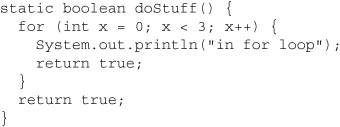
Running this code produces
in for loop
The statement only prints once, because a return causes execution to leave not just the current iteration of a loop, but the entire method. So the iteration expression never runs in that case. Table 5-1 lists the causes and results of abrupt loop termination.
TABLE 5-1 Causes of Early Loop Termination

Basic for Loop: for Loop Issues
None of the three sections of the for declaration are required! The following example is perfectly legal (although not necessarily good practice):

In the preceding example, all the declaration parts are left out so the for loop will act like an endless loop. For the exam, it's important to know that with the absence of the initialization and increment sections, the loop will act like a while loop. The following example demonstrates how this is accomplished:
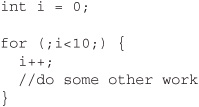
The next example demonstrates a for loop with multiple variables in play. A comma separates the variables, and they must be of the same type. Remember that the variables declared in the for statement are all local to the for loop, and can't be used outside the scope of the loop.

|
|
Variable scope plays a large role in the exam. You need to know that a variable declared in the for loop can't be used beyond the for loop. But a variable only initialized in the for statement (but declared earlier) can be used beyond the loop. For example, the following is legal, |
|
|
|
while this is not |
|
|
|
|
The last thing to note is that all three sections of the for loop are independent of each other. The three expressions in the for statement don't need to operate on the same variables, although they typically do. But even the iterator expression, which many mistakenly call the "increment expression," doesn't need to increment or set anything; you can put in virtually any arbitrary code statements that you want to happen with each iteration of the loop. Look at the following:

The preceding code prints
iterate
iterate
|
|
Many questions in the new (Java 6) exam list "Compilation fails" and "An exception occurs at runtime" as possible answers. This makes it more difficult because you can't simply work through the behavior of the code. You must first make sure the code isn't violating any fundamental rules that will lead to compiler error, and then look for possible exceptions. Only after you've satisfied those two, should you dig into the logic and flow of the code in the question. |
The Enhanced for Loop (for Arrays)
The enhanced for loop, new to Java 6, is a specialized for loop that simplifies looping through an array or a collection. In this chapter we're going to focus on using the enhanced for to loop through arrays. In Chapter 7 we'll revisit the enhanced for as we discuss collections—where the enhanced for really comes into its own.
Instead of having three components, the enhanced for has two. Let's loop through an array the basic (old) way, and then using the enhanced for:

Which produces this output:
![]()
More formally, let's describe the enhanced for as follows:
![]()
The two pieces of the for statement are
![]() declaration The newly declared block variable, of a type compatible with the elements of the array you are accessing. This variable will be available within the for block, and its value will be the same as the current array element.
declaration The newly declared block variable, of a type compatible with the elements of the array you are accessing. This variable will be available within the for block, and its value will be the same as the current array element.
![]() expression This must evaluate to the array you want to loop through. This could be an array variable or a method call that returns an array. The array can be any type: primitives, objects, even arrays of arrays.
expression This must evaluate to the array you want to loop through. This could be an array variable or a method call that returns an array. The array can be any type: primitives, objects, even arrays of arrays.
Using the above definitions, let's look at some legal and illegal enhanced for declarations:
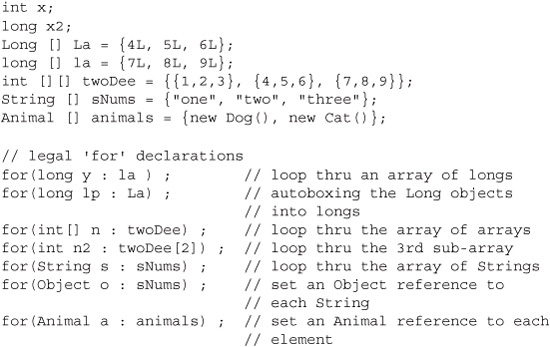

The enhanced for loop assumes that, barring an early exit from the loop, you'll always loop through every element of the array. The following discussions of break and continue apply to both the basic and enhanced for loops.
Using break and continue
The break and continue keywords are used to stop either the entire loop (break) or just the current iteration (continue). Typically if you're using break or continue, you'll do an if test within the loop, and if some condition becomes true (or false depending on the program), you want to get out immediately. The difference between them is whether or not you continue with a new iteration or jump to the first statement below the loop and continue from there.
|
|
Remember, continue statements must be inside a loop; otherwise, you'll get a compiler error. break statements must be used inside either a loop or switch statement. (Note: this does not apply to labeled break statements.). |
The break statement causes the program to stop execution of the innermost loop and start processing the next line of code after the block.
The continue statement causes only the current iteration of the innermost loop to cease and the next iteration of the same loop to start if the condition of the loop is met. When using a continue statement with a for loop, you need to consider the effects that continue has on the loop iteration. Examine the following code:

The question is, is this an endless loop? The answer is no. When the continue statement is hit, the iteration expression still runs! It runs just as though the current iteration ended "in the natural way." So in the preceding example, i will still increment before the condition (i < 10) is checked again. Most of the time, a continue is used within an if test as follows:

Unlabeled Statements
Both the break statement and the continue statement can be unlabeled or labeled. Although it's far more common to use break and continue unlabeled, the exam expects you to know how labeled break and continue statements work. As stated before, a break statement (unlabeled) will exit out of the innermost looping construct and proceed with the next line of code beyond the loop block. The following example demonstrates a break statement:
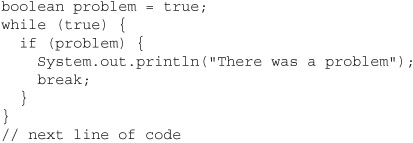
In the previous example, the break statement is unlabeled. The following is an example of an unlabeled continue statement:

In this example, a file is being read one field at a time. When an error is encountered, the program moves to the next field in the file and uses the continue statement to go back into the loop (if it is not at the end of the file) and keeps reading the various fields. If the break command were used instead, the code would stop reading the file once the error occurred and move on to the next line of code after the loop. The continue statement gives you a way to say, "This particular iteration of the loop needs to stop, but not the whole loop itself. I just don't want the rest of the code in this iteration to finish, so do the iteration expression and then start over with the test, and don't worry about what was below the continue statement."
Labeled Statements
Although many statements in a Java program can be labeled, it's most common to use labels with loop statements like for or while, in conjunction with break and continue statements. A label statement must be placed just before the statement being labeled, and it consists of a valid identifier that ends with a colon (:).
You need to understand the difference between labeled and unlabeled break and continue. The labeled varieties are needed only in situations where you have a nested loop, and need to indicate which of the nested loops you want to break from, or from which of the nested loops you want to continue with the next iteration. A break statement will exit out of the labeled loop, as opposed to the innermost loop, if the break keyword is combined with a label. An example of what a label looks like is in the following code:
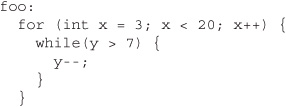
The label must adhere to the rules for a valid variable name and should adhere to the Java naming convention. The syntax for the use of a label name in conjunction with a break statement is the break keyword, then the label name, followed by a semicolon. A more complete example of the use of a labeled break statement is as follows:
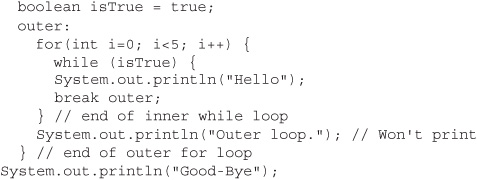
![]()
In this example the word Hello will be printed one time. Then, the labeled break statement will be executed, and the flow will exit out of the loop labeled outer. The next line of code will then print out Good-Bye. Let's see what will happen if the continue statement is used instead of the break statement. The following code example is similar to the preceding one, with the exception of substituting continue for break:
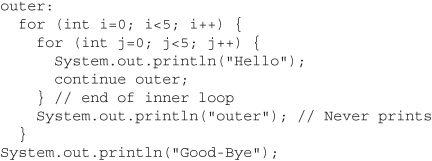
Running this code produces

In this example, Hello will be printed five times. After the continue statement is executed, the flow continues with the next iteration of the loop identified with the label. Finally, when the condition in the outer loop evaluates to false, this loop will finish and Good-Bye will be printed.
EXERCISE 5-2
Creating a Labeled while Loop
Try creating a labeled while loop. Make the label outer and provide a condition to check whether a variable age is less than or equal to 21. Within the loop, increment age by one. Every time the program goes through the loop, check whether age is 16. If it is, print the message "get your driver's license" and continue to the outer loop. If not, print "Another year."
![]() The outer label should appear just before the while loop begins.
The outer label should appear just before the while loop begins.
![]() Make sure age is declared outside of the while loop.
Make sure age is declared outside of the while loop.
|
|
Labeled continue and break statements must be inside the loop that has the same label name; otherwise, the code will not compile. |
CERTIFICATION OBJECTIVE
Handling Exceptions (Exam Objectives 2.4 and 2.5)
2.4 Develop code that makes use of exceptions and exception handling clauses (try, catch, finally), and declares methods and overriding methods that throw exceptions.
2.5 Recognize the effect of an exception arising at a specific point in a code fragment. Note that the exception may be a runtime exception, a checked exception, or an error.
An old maxim in software development says that 80 percent of the work is used 20 percent of the time. The 80 percent refers to the effort required to check and handle errors. In many languages, writing program code that checks for and deals with errors is tedious and bloats the application source into confusing spaghetti.
Still, error detection and handling may be the most important ingredient of any robust application. Java arms developers with an elegant mechanism for handling errors that produces efficient and organized error-handling code: exception handling.
Exception handling allows developers to detect errors easily without writing special code to test return values. Even better, it lets us keep exception-handling code cleanly separated from the exception-generating code. It also lets us use the same exception-handling code to deal with a range of possible exceptions.
The exam has three objectives covering exception handling. We'll cover the first two in this section, and in the next section we'll cover those aspects of exception handling that are new to the exam as of Java 6.
Catching an Exception Using try and catch
Before we begin, let's introduce some terminology. The term "exception" means "exceptional condition" and is an occurrence that alters the normal program flow. A bunch of things can lead to exceptions, including hardware failures, resource exhaustion, and good old bugs. When an exceptional event occurs in Java, an exception is said to be "thrown." The code that's responsible for doing something about the exception is called an "exception handler," and it "catches" the thrown exception.
Exception handling works by transferring the execution of a program to an appropriate exception handler when an exception occurs. For example, if you call a method that opens a file but the file cannot be opened, execution of that method will stop, and code that you wrote to deal with this situation will be run. Therefore, we need a way to tell the JVM what code to execute when a certain exception happens. To do this, we use the try and catch keywords. The try is used to define a block of code in which exceptions may occur. This block of code is called a guarded region (which really means "risky code goes here"). One or more catch clauses match a specific exception (or group of exceptions—more on that later) to a block of code that handles it. Here's how it looks in pseudocode:


In this pseudocode example, lines 2 through 5 constitute the guarded region that is governed by the try clause. Line 7 is an exception handler for an exception of type MyFirstException. Line 12 is an exception handler for an exception of type MySecondException. Notice that the catch blocks immediately follow the try block. This is a requirement; if you have one or more catch blocks, they must immediately follow the try block. Additionally, the catch blocks must all follow each other, without any other statements or blocks in between. Also, the order in which the catch blocks appear matters, as we'll see a little later.
Execution of the guarded region starts at line 2. If the program executes all the way past line 5 with no exceptions being thrown, execution will transfer to line 15 and continue downward. However, if at any time in lines 2 through 5 (the try block) an exception is thrown of type MyFirstException, execution will immediately transfer to line 7. Lines 8 through 10 will then be executed so that the entire catch block runs, and then execution will transfer to line 15 and continue.
Note that if an exception occurred on, say, line 3 of the try block, the rest of the lines in the try block (4 and 5) would never be executed. Once control jumps to the catch block, it never returns to complete the balance of the try block. This is exactly what you want, though. Imagine your code looks something like this pseudocode:
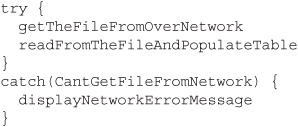
The preceding pseudocode demonstrates how you typically work with exceptions. Code that's dependent on a risky operation (as populating a table with file data is dependent on getting the file from the network) is grouped into a try block in such a way that if, say, the first operation fails, you won't continue trying to run other code that's also guaranteed to fail. In the pseudocode example, you won't be able to read from the file if you can't get the file off the network in the first place.
One of the benefits of using exception handling is that code to handle any particular exception that may occur in the governed region needs to be written only once. Returning to our earlier code example, there may be three different places in our try block that can generate a MyFirstException, but wherever it occurs it will be handled by the same catch block (on line 7). We'll discuss more benefits of exception handling near the end of this chapter.
Using finally
Although try and catch provide a terrific mechanism for trapping and handling exceptions, we are left with the problem of how to clean up after ourselves if an exception occurs. Because execution transfers out of the try block as soon as an exception is thrown, we can't put our cleanup code at the bottom of the try block and expect it to be executed if an exception occurs. Almost as bad an idea would be placing our cleanup code in each of the catch blocks—let's see why.
Exception handlers are a poor place to clean up after the code in the try block because each handler then requires its own copy of the cleanup code. If, for example, you allocated a network socket or opened a file somewhere in the guarded region, each exception handler would have to close the file or release the socket. That would make it too easy to forget to do cleanup, and also lead to a lot of redundant code. To address this problem, Java offers the finally block.
A finally block encloses code that is always executed at some point after the try block, whether an exception was thrown or not. Even if there is a return statement in the try block, the finally block executes right after the return statement is encountered, and before the return executes!
This is the right place to close your files, release your network sockets, and perform any other cleanup your code requires. If the try block executes with no exceptions, the finally block is executed immediately after the try block completes. If there was an exception thrown, the finally block executes immediately after the proper catch block completes. Let's look at another pseudocode example:

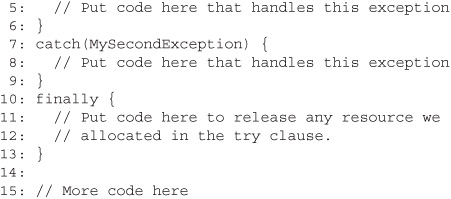
As before, execution starts at the first line of the try block, line 2. If there are no exceptions thrown in the try block, execution transfers to line 11, the first line of the finally block. On the other hand, if a MySecondException is thrown while the code in the try block is executing, execution transfers to the first line of that exception handler, line 8 in the catch clause. After all the code in the catch clause is executed, the program moves to line 11, the first line of the finally clause. Repeat after me: finally always runs! OK, we'll have to refine that a little, but for now, start burning in the idea that finally always runs. If an exception is thrown, finally runs. If an exception is not thrown, finally runs. If the exception is caught, finally runs. If the exception is not caught, finally runs. Later we'll look at the few scenarios in which finally might not run or complete.
Remember, finally clauses are not required. If you don't write one, your code will compile and run just fine. In fact, if you have no resources to clean up after your try block completes, you probably don't need a finally clause. Also, because the compiler doesn't even require catch clauses, sometimes you'll run across code that has a try block immediately followed by a finally block. Such code is useful when the exception is going to be passed back to the calling method, as explained in the next section. Using a finally block allows the cleanup code to execute even when there isn't a catch clause.
The following legal code demonstrates a try with a finally but no catch:

The following legal code demonstrates a try, catch, and finally:
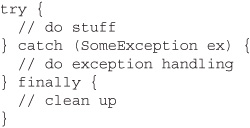
The following ILLEGAL code demonstrates a try without a catch or finally:

The following ILLEGAL code demonstrates a misplaced catch block:

Propagating Uncaught Exceptions
Why aren't catch clauses required? What happens to an exception that's thrown in a try block when there is no catch clause waiting for it? Actually, there's no requirement that you code a catch clause for every possible exception that could be thrown from the corresponding try block. In fact, it's doubtful that you could accomplish such a feat! If a method doesn't provide a catch clause for a particular exception, that method is said to be "ducking" the exception (or "passing the buck").
So what happens to a ducked exception? Before we discuss that, we need to briefly review the concept of the call stack. Most languages have the concept of a method stack or a call stack. Simply put, the call stack is the chain of methods that your program executes to get to the current method. If your program starts in method main() and main() calls method a(), which calls method b(), which in turn calls method c(), the call stack consists of the following:
c
b
a
main
We will represent the stack as growing upward (although it can also be visualized as growing downward). As you can see, the last method called is at the top of the stack, while the first calling method is at the bottom. The method at the very top of the stack trace would be the method you were currently executing. If we move back down the call stack, we're moving from the current method to the previously called method. Figure 5-1 illustrates a way to think about how the call stack in Java works.
FIGURE 5-1 The Java method call stack
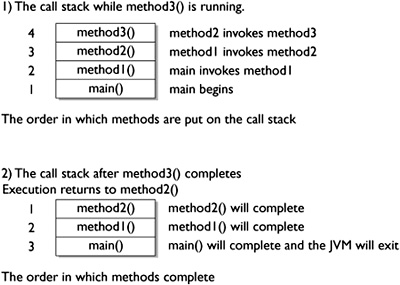
Now let's examine what happens to ducked exceptions. Imagine a building, say, five stories high, and at each floor there is a deck or balcony. Now imagine that on each deck, one person is standing holding a baseball mitt. Exceptions are like balls dropped from person to person, starting from the roof. An exception is first thrown from the top of the stack (in other words, the person on the roof), and if it isn't caught by the same person who threw it (the person on the roof), it drops down the call stack to the previous method, which is the person standing on the deck one floor down. If not caught there, by the person one floor down, the exception/ball again drops down to the previous method (person on the next floor down), and so on until it is caught or until it reaches the very bottom of the call stack. This is called exception propagation.
If an exception reaches the bottom of the call stack, it's like reaching the bottom of a very long drop; the ball explodes, and so does your program. An exception that's never caught will cause your application to stop running. A description (if one is available) of the exception will be displayed, and the call stack will be "dumped." This helps you debug your application by telling you what exception was thrown, from what method it was thrown, and what the stack looked like at the time.
|
|
You can keep throwing an exception down through the methods on the stack. But what about when you get to the main() method at the bottom? You can throw the exception out of main() as well. This results in the Java Virtual Machine (JVM) halting, and the stack trace will be printed to the output. |
|
The following code throws an exception, |
|
|
|
which prints out a stack trace something like, |
|
|
|
|
|
|
EXERCISE 5-3
Propagating and Catching an Exception
In this exercise you're going to create two methods that deal with exceptions. One of the methods is the main() method, which will call another method. If an exception is thrown in the other method, main() must deal with it. A finally statement will be included to indicate that the program has completed. The method that main() will call will be named reverse, and it will reverse the order of the characters in a String. If the String contains no characters, reverse will propagate an exception up to the main() method.
![]() Create a class called Propagate and a main() method, which will remain empty for now.
Create a class called Propagate and a main() method, which will remain empty for now.
![]() Create a method called reverse. It takes an argument of a String and returns a String.
Create a method called reverse. It takes an argument of a String and returns a String.
![]() In reverse, check if the String has a length of 0 by using the String.length() method. If the length is 0, the reverse method will throw an exception.
In reverse, check if the String has a length of 0 by using the String.length() method. If the length is 0, the reverse method will throw an exception.
![]() Now include the code to reverse the order of the String. Because this isn't the main topic of this chapter, the reversal code has been provided, but feel free to try it on your own.
Now include the code to reverse the order of the String. Because this isn't the main topic of this chapter, the reversal code has been provided, but feel free to try it on your own.

![]() Now in the main() method you will attempt to call this method and deal with any potential exceptions. Additionally, you will include a finally statement that displays when main() has finished.
Now in the main() method you will attempt to call this method and deal with any potential exceptions. Additionally, you will include a finally statement that displays when main() has finished.
Defining Exceptions
We have been discussing exceptions as a concept. We know that they are thrown when a problem of some type happens, and we know what effect they have on the flow of our program. In this section we will develop the concepts further and use exceptions in functional Java code. Earlier we said that an exception is an occurrence that alters the normal program flow. But because this is Java, anything that's not a primitive must be…an object. Exceptions are no, well, exception to this rule. Every exception is an instance of a class that has class Exception in its inheritance hierarchy. In other words, exceptions are always some subclass of java.lang.Exception.
When an exception is thrown, an object of a particular Exception subtype is instantiated and handed to the exception handler as an argument to the catch clause. An actual catch clause looks like this:

In this example, e is an instance of the ArrayIndexOutOfBoundsException class. As with any other object, you can call its methods.
Exception Hierarchy
All exception classes are subtypes of class Exception. This class derives from the class Throwable (which derives from the class Object). Figure 5-2 shows the hierarchy for the exception classes.
FIGURE 5-2 Exception class hierarchy
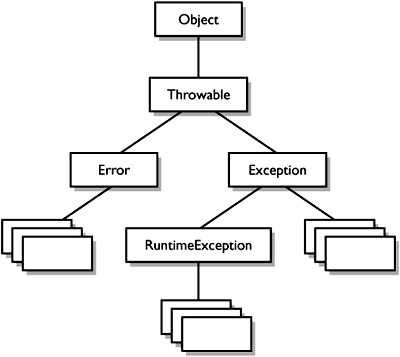
As you can see, there are two subclasses that derive from Throwable: Exception and Error. Classes that derive from Error represent unusual situations that are not caused by program errors, and indicate things that would not normally happen during program execution, such as the JVM running out of memory. Generally, your application won't be able to recover from an Error, so you're not required to handle them. If your code does not handle them (and it usually won't), it will still compile with no trouble. Although often thought of as exceptional conditions, Errors are technically not exceptions because they do not derive from class Exception.
In general, an exception represents something that happens not as a result of a programming error, but rather because some resource is not available or some other condition required for correct execution is not present. For example, if your application is supposed to communicate with another application or computer that is not answering, this is an exception that is not caused by a bug. Figure 5-2 also shows a subtype of Exception called RuntimeException. These exceptions are a special case because they sometimes do indicate program errors. They can also represent rare, difficult-to-handle exceptional conditions. Runtime exceptions are discussed in greater detail later in this chapter.
Java provides many exception classes, most of which have quite descriptive names. There are two ways to get information about an exception. The first is from the type of the exception itself. The next is from information that you can get from the exception object. Class Throwable (at the top of the inheritance tree for exceptions) provides its descendants with some methods that are useful in exception handlers. One of these is printStackTrace(). As expected, if you call an exception object's printStackTrace() method, as in the earlier example, a stack trace from where the exception occurred will be printed.
We discussed that a call stack builds upward with the most recently called method at the top. You will notice that the printStackTrace() method prints the most recently entered method first and continues down, printing the name of each method as it works its way down the call stack (this is called unwinding the stack) from the top.
|
|
For the exam, it is not necessary to know any of the methods contained in the Throwable classes, including Exception and Error . You are expected to know that Exception , Error , RuntimeException , and Throwable types can all be thrown using the throw keyword, and can all be caught (although you rarely will catch anything other than Exception subtypes). |
Handling an Entire Class Hierarchy of Exceptions
We've discussed that the catch keyword allows you to specify a particular type of exception to catch. You can actually catch more than one type of exception in a single catch clause. If the exception class that you specify in the catch clause has no subclasses, then only the specified class of exception will be caught. However, if the class specified in the catch clause does have subclasses, any exception object that subclasses the specified class will be caught as well.
For example, class IndexOutOfBoundsException has two subclasses, ArrayIndexOutOfBoundsException and StringIndexOutOfBoundsException. You may want to write one exception handler that deals with exceptions produced by either type of boundary error, but you might not be concerned with which exception you actually have. In this case, you could write a catch clause like the following:

If any code in the try block throws ArrayIndexOutOfBoundsException or StringIndexOutOfBoundsException, the exception will be caught and handled. This can be convenient, but it should be used sparingly. By specifying an exception class's superclass in your catch clause, you're discarding valuable information about the exception. You can, of course, find out exactly what exception class you have, but if you're going to do that, you're better off writing a separate catch clause for each exception type of interest.

Resist the temptation to write a single catchall exception handler such as the following:
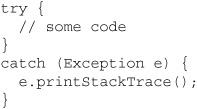
This code will catch every exception generated. Of course, no single exception handler can properly handle every exception, and programming in this way defeats the design objective. Exception handlers that trap many errors at once will probably reduce the reliability of your program because it's likely that an exception will be caught that the handler does not know how to handle.
Exception Matching
If you have an exception hierarchy composed of a superclass exception and a number of subtypes, and you're interested in handling one of the subtypes in a special way but want to handle all the rest together, you need write only two catch clauses.
When an exception is thrown, Java will try to find (by looking at the available catch clauses from the top down) a catch clause for the exception type. If it doesn't find one, it will search for a handler for a supertype of the exception. If it does not find a catch clause that matches a supertype for the exception, then the exception is propagated down the call stack. This process is called exception matching. Let's look at an example:
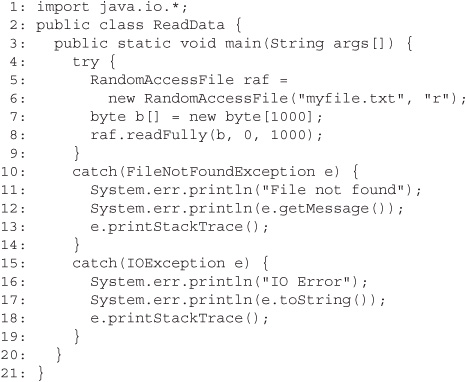
This short program attempts to open a file and to read some data from it. Opening and reading files can generate many exceptions, most of which are some type of IOException. Imagine that in this program we're interested in knowing only whether the exact exception is a FileNotFoundException. Otherwise, we don't care exactly what the problem is.
FileNotFoundException is a subclass of IOException. Therefore, we could handle it in the catch clause that catches all subtypes of IOException, but then we would have to test the exception to determine whether it was a FileNotFoundException. Instead, we coded a special exception handler for the FileNotFoundException and a separate exception handler for all other IOException subtypes.
If this code generates a FileNotFoundException, it will be handled by the catch clause that begins at line 10. If it generates another IOException—perhaps EOFException, which is a subclass of IOException—it will be handled by the catch clause that begins at line 15. If some other exception is generated, such as a runtime exception of some type, neither catch clause will be executed and the exception will be propagated down the call stack.
Notice that the catch clause for the FileNotFoundException was placed above the handler for the IOException. This is really important! If we do it the opposite way, the program will not compile. The handlers for the most specific exceptions must always be placed above those for more general exceptions. The following will not compile:
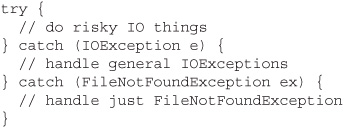
You'll get a compiler error something like this:

If you think back to the people with baseball mitts (in the section "Propagating Uncaught Exceptions"), imagine that the most general mitts are the largest, and can thus catch many different kinds of balls. An IOException mitt is large enough and flexible enough to catch any type of IOException. So if the person on the fifth floor (say, Fred) has a big 'ol IOException mitt, he can't help but catch a FileNotFoundException ball with it. And if the guy (say, Jimmy) on the second floor is holding a FileNotFoundException mitt, that FileNotFoundException ball will never get to him, since it will always be stopped by Fred on the fifth floor, standing there with his big-enough-for-any-IOException mitt.
So what do you do with exceptions that are siblings in the class hierarchy? If one Exception class is not a subtype or supertype of the other, then the order in which the catch clauses are placed doesn't matter.
Exception Declaration and the Public Interface
So, how do we know that some method throws an exception that we have to catch? Just as a method must specify what type and how many arguments it accepts and what is returned, the exceptions that a method can throw must be declared (unless the exceptions are subclasses of RuntimeException). The list of thrown exceptions is part of a method's public interface. The throws keyword is used as follows to list the exceptions that a method can throw:

This method has a void return type, accepts no arguments, and declares that it can throw one of two types of exceptions: either type MyException1 or type MyException2. (Just because the method declares that it throws an exception doesn't mean it always will. It just tells the world that it might.)
Suppose your method doesn't directly throw an exception, but calls a method that does. You can choose not to handle the exception yourself and instead just declare it, as though it were your method that actually throws the exception. If you do declare the exception that your method might get from another method, and you don't provide a try/catch for it, then the method will propagate back to the method that called your method, and either be caught there or continue on to be handled by a method further down the stack.
Any method that might throw an exception (unless it's a subclass of RuntimeException) must declare the exception. That includes methods that aren't actually throwing it directly, but are "ducking" and letting the exception pass down to the next method in the stack. If you "duck" an exception, it is just as if you were the one actually throwing the exception. RuntimeException subclasses are exempt, so the compiler won't check to see if you've declared them. But all non-RuntimeExceptions are considered "checked" exceptions, because the compiler checks to be certain you've acknowledged that "bad things could happen here."
Remember this:
Each method must either handle all checked exceptions by supplying a catch clause or list each unhandled checked exception as a thrown exception.
This rule is referred to as Java's "handle or declare" requirement. (Sometimes called "catch or declare.")
|
|
Look for code that invokes a method declaring an exception, where the calling method doesn't handle or declare the checked exception. The following code (which uses the throw keyword to throw an exception manually—more on this next) has two big problems that the compiler will prevent: |
|
|
|
First, the doMore() method throws a checked exception, but does not declare it! But suppose we fix the doMore() method as follows: |
|
|
|
The doStuff() method is still in trouble because it, too, must declare the IOException , unless it handles it by providing a try/catch , with a catch clause that can take an IOException . |
Again, some exceptions are exempt from this rule. An object of type RuntimeException may be thrown from any method without being specified as part of the method's public interface (and a handler need not be present). And even if a method does declare a RuntimeException, the calling method is under no obligation to handle or declare it. RuntimeException, Error, and all of their subtypes are unchecked exceptions and unchecked exceptions do not have to be specified or handled. Here is an example:

Let's look at myMethod1(). Because EOFException subclasses IOException and IOException subclasses Exception, it is a checked exception and must be declared as an exception that may be thrown by this method. But where will the exception actually come from? The public interface for method myMethod2() called here declares that an exception of this type can be thrown. Whether that method actually throws the exception itself or calls another method that throws it is unimportant to us; we simply know that we have to either catch the exception or declare that we throw it. The method myMethod1() does not catch the exception, so it declares that it throws it. Now let's look at another legal example, myMethod3().

According to the comment, this method can throw a NullPointerException. Because RuntimeException is the superclass of NullPointerException, it is an unchecked exception and need not be declared. We can see that myMethod3() does not declare any exceptions.
Runtime exceptions are referred to as unchecked exceptions. All other exceptions are checked exceptions, and they don't derive from java.lang.RuntimeException. A checked exception must be caught somewhere in your code. If you invoke a method that throws a checked exception but you don't catch the checked exception somewhere, your code will not compile. That's why they're called checked exceptions; the compiler checks to make sure that they're handled or declared. A number of the methods in the Java 2 Standard Edition libraries throw checked exceptions, so you will often write exception handlers to cope with exceptions generated by methods you didn't write.
You can also throw an exception yourself, and that exception can be either an existing exception from the Java API or one of your own. To create your own exception, you simply subclass Exception (or one of its subclasses) as follows:
![]()
And if you throw the exception, the compiler will guarantee that you declare it as follows:

The preceding code upsets the compiler:

You need to know how an Error compares with checked and unchecked exceptions. Objects of type Error are not Exception objects, although they do represent exceptional conditions. Both Exception and Error share a common superclass, Throwable, thus both can be thrown using the throw keyword. When an Error or a subclass of Error is thrown, it's unchecked. You are not required to catch Error objects or Error subtypes. You can also throw an Error yourself (although other than AssertionError you probably won't ever want to), and you can catch one, but again, you probably won't. What, for example, would you actually do if you got an OutOfMemoryError? It's not like you can tell the garbage collector to run; you can bet the JVM fought desperately to save itself (and reclaimed all the memory it could) by the time you got the error. In other words, don't expect the JVM at that point to say, "Run the garbage collector? Oh, thanks so much for telling me. That just never occurred to me. Sure, I'll get right on it." Even better, what would you do if a VirtualMachineError arose? Your program is toast by the time you'd catch the Error, so there's really no point in trying to catch one of these babies. Just remember, though, that you can! The following compiles just fine:
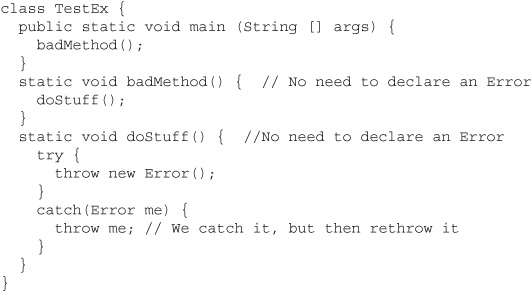
If we were throwing a checked exception rather than Error, then the doStuff() method would need to declare the exception. But remember, since Error is not a subtype of Exception, it doesn't need to be declared. You're free to declare it if you like, but the compiler just doesn't care one way or another when or how the Error is thrown, or by whom.

Because Java has checked exceptions, it's commonly said that Java forces developers to handle exceptions. Yes, Java forces us to write exception handlers for each exception that can occur during normal operation, but it's up to us to make the exception handlers actually do something useful. We know software managers who melt down when they see a programmer write:

Notice anything missing? Don't "eat" the exception by catching it without actually handling it. You won't even be able to tell that the exception occurred, because you'll never see the stack trace.
Rethrowing the Same Exception
Just as you can throw a new exception from a catch clause, you can also throw the same exception you just caught. Here's a catch clause that does this:

All other catch clauses associated with the same try are ignored, if a finally block exists, it runs, and the exception is thrown back to the calling method (the next method down the call stack). If you throw a checked exception from a catch clause, you must also declare that exception! In other words, you must handle and declare, as opposed to handle or declare. The following example is illegal:

In the preceding code, the doStuff() method is clearly able to throw a checked exception—in this case an IOException—so the compiler says, "Well, that's just peachy that you have a try/catch in there, but it's not good enough. If you might rethrow the IOException you catch, then you must declare it!"
EXERCISE 5-4
Creating an Exception
In this exercise we attempt to create a custom exception. We won't put in any new methods (it will have only those inherited from Exception), and because it extends Exception, the compiler considers it a checked exception. The goal of the program is to determine whether a command-line argument, representing a particular food (as a string), is considered bad or OK.
![]() Let's first create our exception. We will call it BadFoodException. This exception will be thrown when a bad food is encountered.
Let's first create our exception. We will call it BadFoodException. This exception will be thrown when a bad food is encountered.
![]() Create an enclosing class called MyException and a main() method, which will remain empty for now.
Create an enclosing class called MyException and a main() method, which will remain empty for now.
![]() Create a method called checkFood(). It takes a String argument and throws our exception if it doesn't like the food it was given. Otherwise, it tells us it likes the food. You can add any foods you aren't particularly fond of to the list.
Create a method called checkFood(). It takes a String argument and throws our exception if it doesn't like the food it was given. Otherwise, it tells us it likes the food. You can add any foods you aren't particularly fond of to the list.
![]() Now in the main() method, you'll get the command-line argument out of the String array, and then pass that String on to the checkFood() method. Because it's a checked exception, the checkFood() method must declare it, and the main() method must handle it (using a try/catch). Do not have main() declare the exception, because if main() ducks the exception, who else is back there to catch it?
Now in the main() method, you'll get the command-line argument out of the String array, and then pass that String on to the checkFood() method. Because it's a checked exception, the checkFood() method must declare it, and the main() method must handle it (using a try/catch). Do not have main() declare the exception, because if main() ducks the exception, who else is back there to catch it?
![]() As nifty as exception handling is, it's still up to the developer to make proper use of it. Exception handling makes organizing our code and signaling problems easy, but the exception handlers still have to be written. You'll find that even the most complex situations can be handled, and your code will be reusable, readable, and maintainable.
As nifty as exception handling is, it's still up to the developer to make proper use of it. Exception handling makes organizing our code and signaling problems easy, but the exception handlers still have to be written. You'll find that even the most complex situations can be handled, and your code will be reusable, readable, and maintainable.
CERTIFICATION OBJECTIVE
Common Exceptions and Errors (Exam Objective 2.6)
2.6 Recognize situations that will result in any of the following being thrown: ArrayIndexOutOfBoundsException, ClassCastException, IllegalArgumentException, IllegalStateException, NullPointerException, NumberFormatException, AssertionError, ExceptionInInitializerError, StackOverflowError, or NoClassDefFoundError. Understand which of these are thrown by the virtual machine and recognize situations in which others should be thrown programmatically.
Exception handling is another area that the exam creation team decided to expand for the SCJP 5 exam. This section discusses the aspects of exceptions that were added for this new version. The intention of Objective 2.6 is to make sure that you are familiar with some of the most common exceptions and errors you'll encounter as a Java programmer.
|
|
The questions from this section are likely to be along the lines of, "Here's some code that just did something bad, which exception will be thrown?" |
|
Throughout the exam, questions will present some code and ask you to determine whether the code will run, or whether an exception will be thrown. Since these questions are so common, understanding the causes for these exceptions is critical to your success. |
This is another one of those objectives that will turn up all through the real exam (does "An exception is thrown at runtime" ring a bell?), so make sure this section gets a lot of your attention.
Where Exceptions Come From
Jump back a page and take a look at the last sentence of Objective 2.6. It's important to understand what causes exceptions and errors, and where they come from. For the purposes of exam preparation, let's define two broad categories of exceptions and errors:
![]() JVM exceptions Those exceptions or errors that are either exclusively or most logically thrown by the JVM.
JVM exceptions Those exceptions or errors that are either exclusively or most logically thrown by the JVM.
![]() Programmatic exceptions Those exceptions that are thrown explicitly by application and/or API programmers.
Programmatic exceptions Those exceptions that are thrown explicitly by application and/or API programmers.
JVM Thrown Exceptions
Let's start with a very common exception, the NullPointerException. As we saw in Chapter 3, this exception occurs when you attempt to access an object using a reference variable with a current value of null. There's no way that the compiler can hope to find these problems before runtime. Let's look at the following:

Surely, the compiler can find the problem with that tiny little program! Nope, you're on your own. The code will compile just fine, and the JVM will throw a NullPointerException when it tries to invoke the length() method.
Earlier in this chapter we discussed the call stack. As you recall, we used the convention that main() would be at the bottom of the call stack, and that as main() invokes another method, and that method invokes another, and so on, the stack grows upward. Of course the stack resides in memory, and even if your OS gives you a gigabyte of RAM for your program, it's still a finite amount. It's possible to grow the stack so large that the OS runs out of space to store the call stack. When this happens you get (wait for it…), a StackOverflowError. The most common way for this to occur is to create a recursive method. A recursive method is one that invokes itself in the method body. While that may sound weird, it's a very common and useful technique for such things as searching and sorting algorithms. Take a look at this code:

As you can see, if you ever make the mistake of invoking the go() method, your program will fall into a black hole; go() invoking go() invoking go(), until, no matter how much memory you have, you'll get a StackOverflowError. Again, only the JVM knows when this moment occurs, and the JVM will be the source of this error.
Programmatically Thrown Exceptions
Now let's look at programmatically thrown exceptions. Remember we defined "programmatically" as meaning something like this:
Created by an application and/or API developer.
For instance, many classes in the Java API have methods that take String arguments, and convert these Strings into numeric primitives. A good example of these classes are the so-called "wrapper classes" that we studied in Chapter 3.
At some point long ago, some programmer wrote the java.lang. Integer class, and created methods like parseInt() and valueOf(). That programmer wisely decided that if one of these methods was passed a String that could not be converted into a number, the method should throw a NumberFormatException. The partially implemented code might look something like this:

Other examples of programmatic exceptions include an AssertionError (okay, it's not an exception, but it IS thrown programmatically), and throwing an IllegalArgumentException. In fact, our mythical API developer could have used IllegalArgumentException for her parseInt() method. But it turns out that NumberFormatException extends IllegalArgumentException, and is a little more precise, so in this case, using NumberFormatException supports the notion we discussed earlier: that when you have an exception hierarchy, you should use the most precise exception that you can.
Of course, as we discussed earlier, you can also make up your very own special, custom exceptions, and throw them whenever you want to. These homemade exceptions also fall into the category of "programmatically thrown exceptions."
A Summary of the Exam's Exceptions and Errors
Objective 2.6 lists ten specific exceptions and errors. In this section we discussed the StackOverflowError. The other nine exceptions and errors listed in the objective are covered elsewhere in this book. Table 5-2 summarizes this list and provides chapter references to the exceptions and errors we did not discuss here.
TABLE 5-2 Descriptions and Sources of Common Exceptions.
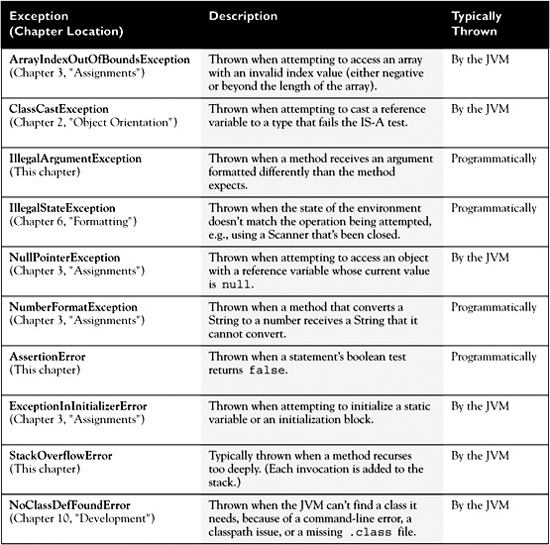
CERTIFICATION OBJECTIVE
Working with the Assertion Mechanism (Exam Objective 2.3)
2.3 Develop code that makes use of assertions, and distinguish appropriate from inappropriate uses of assertions.
You know you're not supposed to make assumptions, but you can't help it when you're writing code. You put them in comments:
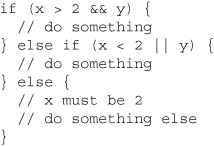
You write print statements with them:

Added to the Java language beginning with version 1.4, assertions let you test your assumptions during development, without the expense (in both your time and program overhead) of writing exception handlers for exceptions that you assume will never happen once the program is out of development and fully deployed.
Starting with exam 310-035 (version 1.4 of the Sun Certified Java Programmer exam) and continuing through to the current exam 310-065 (SCJP 6), you're expected to know the basics of how assertions work, including how to enable them, how to use them, and how not to use them.
Assertions Overview
Suppose you assume that a number passed into a method (say, methodA()) will never be negative. While testing and debugging, you want to validate your assumption, but you don't want to have to strip out print statements, runtime exception handlers, or if/else tests when you're done with development. But leaving any of those in is, at the least, a performance hit. Assertions to the rescue! Check out the following code:

Because you're so certain of your assumption, you don't want to take the time (or program performance hit) to write exception-handling code. And at runtime, you don't want the if/else either because if you do reach the else condition, it means your earlier logic (whatever was running prior to this method being called) is flawed.
Assertions let you test your assumptions during development, but the assertion code basically evaporates when the program is deployed, leaving behind no overhead or debugging code to track down and remove. Let's rewrite methodA() to validate that the argument was not negative:

Not only do assertions let your code stay cleaner and tighter, but because assertions are inactive unless specifically "turned on" (enabled), the code will run as though it were written like this:

Assertions work quite simply. You always assert that something is true. If it is, no problem. Code keeps running. But if your assertion turns out to be wrong (false), then a stop-the-world AssertionError is thrown (that you should never, ever handle!) right then and there, so you can fix whatever logic flaw led to the problem.
Assertions come in two flavors: really simple and simple, as follows:
Really simple:

Simple:

The difference between the two is that the simple version adds a second expression, separated from the first (boolean expression) by a colon, this expression's string value is added to the stack trace. Both versions throw an immediate AssertionError, but the simple version gives you a little more debugging help while the really simple version simply tells you only that your assumption was false.

Assertions are typically enabled when an application is being tested and debugged, but disabled when the application is deployed. The assertions are still in the code, although ignored by the JVM, so if you do have a deployed application that starts misbehaving, you can always choose to enable assertions in the field for additional testing.
Assertion Expression Rules
Assertions can have either one or two expressions, depending on whether you're using the "simple" or the "really simple." The first expression must always result in a boolean value! Follow the same rules you use for if and while tests. The whole point is to assert aTest, which means you're asserting that aTest is true. If it is true, no problem. If it's not true, however, then your assumption was wrong and you get an AssertionError.
The second expression, used only with the simple version of an assert statement, can be anything that results in a value. Remember, the second expression is used to generate a String message that displays in the stack trace to give you a little more debugging information. It works much like System.out.println() in that you can pass it a primitive or an object, and it will convert it into a String representation. It must resolve to a value!
The following code lists legal and illegal expressions for both parts of an assert statement. Remember, expression2 is used only with the simple assert statement, where the second expression exists solely to give you a little more debugging detail:

Enabling Assertions
If you want to use assertions, you have to think first about how to compile with assertions in your code, and then about how to run with assertions enabled. Both require version 1.4 or greater, and that brings us to the first issue: how to compile with assertions in your code.
Identifier vs. Keyword
Prior to version 1.4, you might very well have written code like this:

Notice that in the preceding code, assert is used as an identifier. That's not a problem prior to 1.4. But you cannot use a keyword/reserved word as an identifier, and beginning with version 1.4, assert is a keyword. The bottom line is this:
You can use assert as a keyword or as an identifier, but not both.

If for some reason you're using a Java 1.4 compiler, and if you're using assert as a keyword (in other words, you're actually trying to assert something in your code), then you must explicitly enable assertion-awareness at compile time, as follows:
![]()
You can read that as "compile the class TestClass, in the directory com/geeksanonymous , and do it in the 1.4 way, where assert is a keyword."
Use version 6 of java and javac
As far as the exam is concerned, you'll ALWAYS be using version 6 of the Java compiler (javac), and version 6 of the Java application launcher (java). You might see questions about older versions of source code, but those questions will always be in the context of compiling and launching old code with the current versions of javac and java.
Compiling Assertion-Aware Code
The Java 6 compiler will use the assert keyword by default. Unless you tell it otherwise, the compiler will generate an error message if it finds the word assert used as an identifier. However, you can tell the compiler that you're giving it an old piece of code to compile, and that it should pretend to be an old compiler! (More about compiler commands in Chapter 10.) Let's say you've got to make a quick fix to an old piece of 1.3 code that uses assert as an identifier. At the command line you can type
![]()
The compiler will issue warnings when it discovers the word assert used as an identifier, but the code will compile and execute. Suppose you tell the compiler that your code is version 1.4 or later, for instance:
![]()
In this case, the compiler will issue errors when it discovers the word assert used as an identifier.
If you want to tell the compiler to use Java 6 rules you can do one of three things: omit the -source option, which is the default, or add one of two source options:
![]()
If you want to use assert as an identifier in your code, you MUST compile using the -source 1.3 option. Table 5-3 summarizes how the Java 6 compiler will react to assert as either an identifier or a keyword.
TABLE 5-3 Using Java 6 to Compile Code That Uses assert as an Identifier or a Keyword
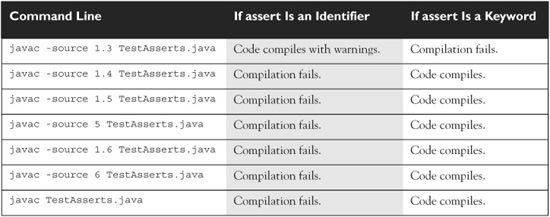
Running with Assertions
Here's where it gets cool. Once you've written your assertion-aware code (in other words, code that uses assert as a keyword, to actually perform assertions at runtime), you can choose to enable or disable your assertions at runtime! Remember, assertions are disabled by default.
Enabling Assertions at Runtime
You enable assertions at runtime with
![]()
or
![]()
The preceding command-line switches tell the JVM to run with assertions enabled.
Disabling assertions at runtime
You must also know the command-line switches for disabling assertions,
![]()
or
![]()
Because assertions are disabled by default, using the disable switches might seem unnecessary. Indeed, using the switches the way we do in the preceding example just gives you the default behavior (in other words, you get the same result regardless of whether you use the disabling switches). But…you can also selectively enable and disable assertions in such a way that they're enabled for some classes and/or packages, and disabled for others, while a particular program is running.
Selective Enabling and Disabling
The command-line switches for assertions can be used in various ways:
![]() With no arguments (as in the preceding examples) Enables or disables assertions in all classes, except for the system classes.
With no arguments (as in the preceding examples) Enables or disables assertions in all classes, except for the system classes.
![]() With a package name Enables or disables assertions in the package specified, and any packages below this package in the same directory hierarchy (more on that in a moment).
With a package name Enables or disables assertions in the package specified, and any packages below this package in the same directory hierarchy (more on that in a moment).
![]() With a class name Enables or disables assertions in the class specified.
With a class name Enables or disables assertions in the class specified.
You can combine switches to, say, disable assertions in a single class, but keep them enabled for all others, as follows:
![]()
The preceding command line tells the JVM to enable assertions in general, but disable them in the class com.geeksanonymous.Foo. You can do the same selectivity for a package as follows:
![]()
The preceding command line tells the JVM to enable assertions in general, but disable them in the package com.geeksanonymous, and all of its subpackages! You may not be familiar with the term subpackages, since there wasn't much use of that term prior to assertions. A subpackage is any package in a subdirectory of the named package. For example, look at the following directory tree:

This tree lists three directories,
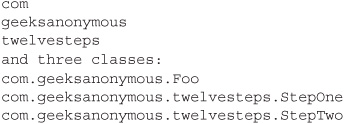
The subpackage of com.geeksanonymous is the twelvesteps package. Remember that in Java, the com.geeksanonymous.twelvesteps package is treated as a completely distinct package that has no relationship with the packages above it (in this example, the com.geeksanonymous package), except they just happen to share a couple of directories. Table 5-4 lists examples of command-line switches for enabling and disabling assertions.
TABLE 5-4 Assertion Command-Line Switches
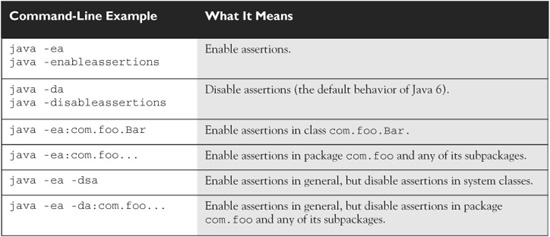
Using Assertions Appropriately
Not all legal uses of assertions are considered appropriate. As with so much of Java, you can abuse the intended use of assertions, despite the best efforts of Sun's Java engineers to discourage you from doing so. For example, you're never supposed to handle an assertion failure. That means you shouldn't catch it with a catch clause and attempt to recover. Legally, however, AssertionError is a subclass of Throwable, so it can be caught. But just don't do it! If you're going to try to recover from something, it should be an exception. To discourage you from trying to substitute an assertion for an exception, the AssertionError doesn't provide access to the object that generated it. All you get is the String message.
So who gets to decide what's appropriate? Sun. The exam uses Sun's "official" assertion documentation to define appropriate and inappropriate uses.
Don't Use Assertions to validate Arguments to a Public Method
The following is an inappropriate use of assertions:

|
|
If you see the word "appropriate" on the exam, do not mistake that for "legal." "Appropriate" always refers to the way in which something is supposed to be used, according to either the developers of the mechanism or best practices officially embraced by Sun. If you see the word "correct" in the context of assertions, as in, "Line 3 is a correct use of assertions," you should also assume that correct is referring to how assertions SHOULD be used rather than how they legally COULD be used. |
A public method might be called from code that you don't control (or from code you have never seen). Because public methods are part of your interface to the outside world, you're supposed to guarantee that any constraints on the arguments will be enforced by the method itself. But since assertions aren't guaranteed to actually run (they're typically disabled in a deployed application), the enforcement won't happen if assertions aren't enabled. You don't want publicly accessible code that works only conditionally, depending on whether assertions are enabled.
If you need to validate public method arguments, you'll probably use exceptions to throw, say, an IllegalArgumentException if the values passed to the public method are invalid.
Do Use Assertions to validate Arguments to a Private Method
If you write a private method, you almost certainly wrote (or control) any code that calls it. When you assume that the logic in code calling your private method is correct, you can test that assumption with an assertion as follows:

The only difference that matters between the preceding example and the one before it is the access modifier. So, do enforce constraints on private methods' arguments, but do not enforce constraints on public methods. You're certainly free to compile assertion code with an inappropriate validation of public arguments, but for the exam (and real life) you need to know that you shouldn't do it.
Don't Use Assertions to validate Command-Line Arguments
This is really just a special case of the "Do not use assertions to validate arguments to a public method" rule. If your program requires command-line arguments, you'll probably use the exception mechanism to enforce them.
Do Use Assertions, Even in Public Methods, to Check for Cases that You Know Are Never, Ever supposed to Happen
This can include code blocks that should never be reached, including the default of a switch statement as follows:

If you assume that a particular code block won't be reached, as in the preceding example where you assert that x must be either 1, 2, or 3, then you can use assert false to cause an AssertionError to be thrown immediately if you ever do reach that code. So in the switch example, we're not performing a boolean test—we've already asserted that we should never be there, so just getting to that point is an automatic failure of our assertion/assumption.
Don't Use Assert Expressions that Can Cause Side Effects!
The following would be a very bad idea:
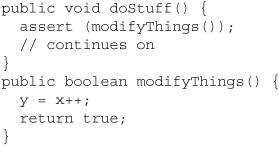
The rule is, an assert expression should leave the program in the same state it was in before the expression! Think about it. assert expressions aren't guaranteed to always run, so you don't want your code to behave differently depending on whether assertions are enabled. Assertions must not cause any side effects. If assertions are enabled, the only change to the way your program runs is that an AssertionError can be thrown if one of your assertions (think: assumptions) turns out to be false.

Using assertions that cause side effects can cause some of the most maddening and hard-to-find bugs known to man! When a hot tempered Q.A. analyst is screaming at you that your code doesn't work, trotting out the old "well it works on MY machine" excuse won't get you very far.
CERTIFICATION SUMMARY
This chapter covered a lot of ground, all of which involves ways of controlling your program flow, based on a conditional test. First you learned about if and switch statements. The if statement evaluates one or more expressions to a boolean result. If the result is true, the program will execute the code in the block that is encompassed by the if. If an else statement is used and the if expression evaluates to false, then the code following the else will be performed. If no else block is defined, then none of the code associated with the if statement will execute.
You also learned that the switch statement can be used to replace multiple if-else statements. The switch statement can evaluate integer primitive types that can be implicitly cast to an int (those types are byte, short, int, and char), or it can evaluate enums.
At runtime, the JVM will try to find a match between the expression in the switch statement and a constant in a corresponding case statement. If a match is found, execution will begin at the matching case, and continue on from there, executing code in all the remaining case statements until a break statement is found or the end of the switch statement occurs. If there is no match, then the default case will execute, if there is one.
You've learned about the three looping constructs available in the Java language. These constructs are the for loop (including the basic for and the enhanced for which is new to Java 6), the while loop, and the do loop. In general, the for loop is used when you know how many times you need to go through the loop. The while loop is used when you do not know how many times you want to go through, whereas the do loop is used when you need to go through at least once. In the for loop and the while loop, the expression will have to evaluate to true to get inside the block and will check after every iteration of the loop. The do loop does not check the condition until after it has gone through the loop once. The major benefit of the for loop is the ability to initialize one or more variables and increment or decrement those variables in the for loop definition.
The break and continue statements can be used in either a labeled or unlabeled fashion. When unlabeled, the break statement will force the program to stop processing the innermost looping construct and start with the line of code following the loop. Using an unlabeled continue command will cause the program to stop execution of the current iteration of the innermost loop and proceed with the next iteration. When a break or a continue statement is used in a labeled manner, it will perform in the same way, with one exception: the statement will not apply to the innermost loop; instead, it will apply to the loop with the label. The break statement is used most often in conjunction with the switch statement. When there is a match between the switch expression and the case constant, the code following the case constant will be performed. To stop execution, a break is needed.
You've seen how Java provides an elegant mechanism in exception handling. Exception handling allows you to isolate your error-correction code into separate blocks so that the main code doesn't become cluttered by error-checking code. Another elegant feature allows you to handle similar errors with a single error-handling block, without code duplication. Also, the error handling can be deferred to methods further back on the call stack.
You learned that Java's try keyword is used to specify a guarded region—a block of code in which problems might be detected. An exception handler is the code that is executed when an exception occurs. The handler is defined by using Java's catch keyword. All catch clauses must immediately follow the related try block. Java also provides the finally keyword. This is used to define a block of code that is always executed, either immediately after a catch clause completes or immediately after the associated try block in the case that no exception was thrown (or there was a try but no catch). Use finally blocks to release system resources and to perform any cleanup required by the code in the try block. A finally block is not required, but if there is one it must immediately follow the last catch. (If there is no catch block, the finally block must immediately follow the try block.) It's guaranteed to be called except when the try or catch issues a System.exit().
An exception object is an instance of class Exception or one of its subclasses. The catch clause takes, as a parameter, an instance of an object of a type derived from the Exception class. Java requires that each method either catches any checked exception it can throw or else declares that it throws the exception. The exception declaration is part of the method's public interface. To declare that an exception may be thrown, the throws keyword is used in a method definition, along with a list of all checked exceptions that might be thrown.
Runtime exceptions are of type RuntimeException (or one of its subclasses). These exceptions are a special case because they do not need to be handled or declared, and thus are known as "unchecked" exceptions. Errors are of type java.lang.Error or its subclasses, and like runtime exceptions, they do not need to be handled or declared. Checked exceptions include any exception types that are not of type RuntimeException or Error. If your code fails to either handle a checked exception or declare that it is thrown, your code won't compile. But with unchecked exceptions or objects of type Error, it doesn't matter to the compiler whether you declare them or handle them, do nothing about them, or do some combination of declaring and handling. In other words, you're free to declare them and handle them, but the compiler won't care one way or the other. It's not good practice to handle an Error, though, because you can rarely recover from one.
Exceptions can be generated by the JVM, or by a programmer.
Assertions, added to the language in version 1.4, are a useful debugging tool. You learned how you can use them for testing, by enabling them, but keep them disabled when the application is deployed. If you have older Java code that uses the word assert as an identifier, then you won't be able to use assertions, and you must recompile your older code using the -source 1.3 flag. Remember that as of Java 6, assertions are compiled as a keyword by default, but must be enabled explicitly at runtime.
You learned how assert statements always include a boolean expression, and if the expression is true the code continues on, but if the expression is false, an AssertionError is thrown. If you use the two-expression assert statement, then the second expression is evaluated, converted to a String representation and inserted into the stack trace to give you a little more debugging info. Finally, you saw why assertions should not be used to enforce arguments to public methods, and why assert expressions must not contain side effects!

TWO-MINUTE DRILL
Here are some of the key points from each certification objective in this chapter. You might want to loop through them several times.
Writing Code Using if and switch statements (obj. 2.1)
![]() The only legal expression in an if statement is a boolean expression, in other words an expression that resolves to a boolean or a Boolean variable.
The only legal expression in an if statement is a boolean expression, in other words an expression that resolves to a boolean or a Boolean variable.
![]() Watch out for boolean assignments (=) that can be mistaken for boolean equality (==) tests:
Watch out for boolean assignments (=) that can be mistaken for boolean equality (==) tests:
![]()
![]() Curly braces are optional for if blocks that have only one conditional statement. But watch out for misleading indentations.
Curly braces are optional for if blocks that have only one conditional statement. But watch out for misleading indentations.
![]() switch statements can evaluate only to enums or the byte, short, int, and char data types. You can't say,
switch statements can evaluate only to enums or the byte, short, int, and char data types. You can't say,
![]()
![]() The case constant must be a literal or final variable, or a constant expression, including an enum. You cannot have a case that includes a non-final variable, or a range of values.
The case constant must be a literal or final variable, or a constant expression, including an enum. You cannot have a case that includes a non-final variable, or a range of values.
![]() If the condition in a switch statement matches a case constant, execution will run through all code in the switch following the matching case statement until a break statement or the end of the switch statement is encountered. In other words, the matching case is just the entry point into the case block, but unless there's a break statement, the matching case is not the only case code that runs.
If the condition in a switch statement matches a case constant, execution will run through all code in the switch following the matching case statement until a break statement or the end of the switch statement is encountered. In other words, the matching case is just the entry point into the case block, but unless there's a break statement, the matching case is not the only case code that runs.
![]() The default keyword should be used in a switch statement if you want to run some code when none of the case values match the conditional value.
The default keyword should be used in a switch statement if you want to run some code when none of the case values match the conditional value.
![]() The default block can be located anywhere in the switch block, so if no case matches, the default block will be entered, and if the default does not contain a break, then code will continue to execute (fall-through) to the end of the switch or until the break statement is encountered.
The default block can be located anywhere in the switch block, so if no case matches, the default block will be entered, and if the default does not contain a break, then code will continue to execute (fall-through) to the end of the switch or until the break statement is encountered.
Writing Code Using Loops (objective 2.2)
![]() A basic for statement has three parts: declaration and/or initialization, boolean evaluation, and the iteration expression.
A basic for statement has three parts: declaration and/or initialization, boolean evaluation, and the iteration expression.
![]() If a variable is incremented or evaluated within a basic for loop, it must be declared before the loop, or within the for loop declaration.
If a variable is incremented or evaluated within a basic for loop, it must be declared before the loop, or within the for loop declaration.
![]() A variable declared (not just initialized) within the basic for loop declaration cannot be accessed outside the for loop (in other words, code below the for loop won't be able to use the variable).
A variable declared (not just initialized) within the basic for loop declaration cannot be accessed outside the for loop (in other words, code below the for loop won't be able to use the variable).
![]() You can initialize more than one variable of the same type in the first part of the basic for loop declaration; each initialization must be separated by a comma.
You can initialize more than one variable of the same type in the first part of the basic for loop declaration; each initialization must be separated by a comma.
![]() An enhanced for statement (new as of Java 6), has two parts, the declaration and the expression. It is used only to loop through arrays or collections.
An enhanced for statement (new as of Java 6), has two parts, the declaration and the expression. It is used only to loop through arrays or collections.
![]() With an enhanced for, the expression is the array or collection through which you want to loop.
With an enhanced for, the expression is the array or collection through which you want to loop.
![]() With an enhanced for, the declaration is the block variable, whose type is compatible with the elements of the array or collection, and that variable contains the value of the element for the given iteration.
With an enhanced for, the declaration is the block variable, whose type is compatible with the elements of the array or collection, and that variable contains the value of the element for the given iteration.
![]() You cannot use a number (old C-style language construct) or anything that does not evaluate to a boolean value as a condition for an if statement or looping construct. You can't, for example, say if(x), unless x is a boolean variable.
You cannot use a number (old C-style language construct) or anything that does not evaluate to a boolean value as a condition for an if statement or looping construct. You can't, for example, say if(x), unless x is a boolean variable.
![]() The do loop will enter the body of the loop at least once, even if the test condition is not met.
The do loop will enter the body of the loop at least once, even if the test condition is not met.
Using break and continue (objective 2.2)
![]() An unlabeled break statement will cause the current iteration of the innermost looping construct to stop and the line of code following the loop to run.
An unlabeled break statement will cause the current iteration of the innermost looping construct to stop and the line of code following the loop to run.
![]() An unlabeled continue statement will cause: the current iteration of the innermost loop to stop, the condition of that loop to be checked, and if the condition is met, the loop to run again.
An unlabeled continue statement will cause: the current iteration of the innermost loop to stop, the condition of that loop to be checked, and if the condition is met, the loop to run again.
![]() If the break statement or the continue statement is labeled, it will cause similar action to occur on the labeled loop, not the innermost loop.
If the break statement or the continue statement is labeled, it will cause similar action to occur on the labeled loop, not the innermost loop.
Handling Exceptions (objectives 2.4, 2.5, and 2.6)
![]() Exceptions come in two flavors: checked and unchecked.
Exceptions come in two flavors: checked and unchecked.
![]() Checked Exceptions include all subtypes of Exception, excluding classes that extend RuntimeException.
Checked Exceptions include all subtypes of Exception, excluding classes that extend RuntimeException.
![]() Checked exceptions are subject to the handle or declare rule; any method that might throw a checked exception (including methods that invoke methods that can throw a checked exception) must either declare the exception using throws, or handle the exception with an appropriate try/catch.
Checked exceptions are subject to the handle or declare rule; any method that might throw a checked exception (including methods that invoke methods that can throw a checked exception) must either declare the exception using throws, or handle the exception with an appropriate try/catch.
![]() Subtypes of Error or RuntimeException are unchecked, so the compiler doesn't enforce the handle or declare rule. You're free to handle them, or to declare them, but the compiler doesn't care one way or the other.
Subtypes of Error or RuntimeException are unchecked, so the compiler doesn't enforce the handle or declare rule. You're free to handle them, or to declare them, but the compiler doesn't care one way or the other.
![]() If you use an optional finally block, it will always be invoked, regardless of whether an exception in the corresponding try is thrown or not, and regardless of whether a thrown exception is caught or not.
If you use an optional finally block, it will always be invoked, regardless of whether an exception in the corresponding try is thrown or not, and regardless of whether a thrown exception is caught or not.
![]() The only exception to the finally-will-always-be-called rule is that a finally will not be invoked if the JVM shuts down. That could happen if code from the try or catch blocks calls System.exit().
The only exception to the finally-will-always-be-called rule is that a finally will not be invoked if the JVM shuts down. That could happen if code from the try or catch blocks calls System.exit().
![]() Just because finally is invoked does not mean it will complete. Code in the finally block could itself raise an exception or issue a System.exit().
Just because finally is invoked does not mean it will complete. Code in the finally block could itself raise an exception or issue a System.exit().
![]() Uncaught exceptions propagate back through the call stack, starting from the method where the exception is thrown and ending with either the first method that has a corresponding catch for that exception type or a JVM shutdown (which happens if the exception gets to main(), and main() is "ducking" the exception by declaring it).
Uncaught exceptions propagate back through the call stack, starting from the method where the exception is thrown and ending with either the first method that has a corresponding catch for that exception type or a JVM shutdown (which happens if the exception gets to main(), and main() is "ducking" the exception by declaring it).
![]() You can create your own exceptions, normally by extending Exception or one of its subtypes. Your exception will then be considered a checked exception, and the compiler will enforce the handle or declare rule for that exception.
You can create your own exceptions, normally by extending Exception or one of its subtypes. Your exception will then be considered a checked exception, and the compiler will enforce the handle or declare rule for that exception.
![]() All catch blocks must be ordered from most specific to most general. If you have a catch clause for both IOException and Exception, you must put the catch for IOException first in your code. Otherwise, the IOException would be caught by catch(Exception e), because a catch argument can catch the specified exception or any of its subtypes! The compiler will stop you from defining catch clauses that can never be reached.
All catch blocks must be ordered from most specific to most general. If you have a catch clause for both IOException and Exception, you must put the catch for IOException first in your code. Otherwise, the IOException would be caught by catch(Exception e), because a catch argument can catch the specified exception or any of its subtypes! The compiler will stop you from defining catch clauses that can never be reached.
![]() Some exceptions are created by programmers, some by the JVM.
Some exceptions are created by programmers, some by the JVM.
Working with the Assertion Mechanism (objective 2.3)
![]() Assertions give you a way to test your assumptions during development and debugging.
Assertions give you a way to test your assumptions during development and debugging.
![]() Assertions are typically enabled during testing but disabled during deployment.
Assertions are typically enabled during testing but disabled during deployment.
![]() You can use assert as a keyword (as of version 1.4) or an identifier, but not both together. To compile older code that uses assert as an identifier (for example, a method name), use the -source 1.3 command-line flag to javac.
You can use assert as a keyword (as of version 1.4) or an identifier, but not both together. To compile older code that uses assert as an identifier (for example, a method name), use the -source 1.3 command-line flag to javac.
![]() Assertions are disabled at runtime by default. To enable them, use a command-line flag -ea or -enableassertions.
Assertions are disabled at runtime by default. To enable them, use a command-line flag -ea or -enableassertions.
![]() Selectively disable assertions by using the -da or -disableassertions flag.
Selectively disable assertions by using the -da or -disableassertions flag.
![]() If you enable or disable assertions using the flag without any arguments, you're enabling or disabling assertions in general. You can combine enabling and disabling switches to have assertions enabled for some classes and/or packages, but not others.
If you enable or disable assertions using the flag without any arguments, you're enabling or disabling assertions in general. You can combine enabling and disabling switches to have assertions enabled for some classes and/or packages, but not others.
![]() You can enable and disable assertions on a class-by-class basis, using the following syntax:
You can enable and disable assertions on a class-by-class basis, using the following syntax:
java -ea -da:MyClass TestClass
![]() You can enable and disable assertions on a package-by-package basis, and any package you specify also includes any subpackages (packages further down the directory hierarchy).
You can enable and disable assertions on a package-by-package basis, and any package you specify also includes any subpackages (packages further down the directory hierarchy).
![]() Do not use assertions to validate arguments to public methods.
Do not use assertions to validate arguments to public methods.
![]() Do not use assert expressions that cause side effects. Assertions aren't guaranteed to always run, and you don't want behavior that changes depending on whether assertions are enabled.
Do not use assert expressions that cause side effects. Assertions aren't guaranteed to always run, and you don't want behavior that changes depending on whether assertions are enabled.
![]() Do use assertions—even in public methods—to validate that a particular code block will never be reached. You can use assert false; for code that should never be reached, so that an assertion error is thrown immediately if the assert statement is executed.
Do use assertions—even in public methods—to validate that a particular code block will never be reached. You can use assert false; for code that should never be reached, so that an assertion error is thrown immediately if the assert statement is executed.
SELF TEST
1. Given two files:
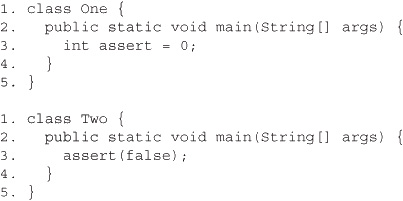
And the four command-line invocations:

What is the result? (Choose all that apply.)
A. Only one compilation will succeed
B. Exactly two compilations will succeed
C. Exactly three compilations will succeed
D. All four compilations will succeed
E. No compiler warnings will be produced
F. At least one compiler warning will be produced
2. Given:

What is the result?
A. -
B. -c
C. -c2
D. -2c
E. -c22b
F. -2c2b
G. -2c2bc
H. Compilation fails
3. Given:
![]()
Which could be used to create an appropriate catch block? (Choose all that apply.)
A. ClassCastException
B. IllegalStateException
C. NumberFormatException
D. IllegalArgumentException
E. ExceptionInInitializerError
F. ArrayIndexOutOfBoundsException
4. Which are true? (Choose all that apply.)
A. It is appropriate to use assertions to validate arguments to methods marked public
B. It is appropriate to catch and handle assertion errors
C. It is NOT appropriate to use assertions to validate command-line arguments
D. It is appropriate to use assertions to generate alerts when you reach code that should not be reachable
E. It is NOT appropriate for assertions to change a program's state
5. Given:

Which, inserted independently at line 4, compiles? (Choose all that apply.)
A. for(int y : x) {
B. for(x : int y) {
C. int y = 0; for(y : x) {
D. for(int y=0, z=0; z<x.length; z++) { y = x[z];
E. for(int y=0, int z=0; z<x.length; z++) { y = x[z];
F. int y = 0; for(int z=0; z<x.length; z++) { y = x[z];
6. Given:
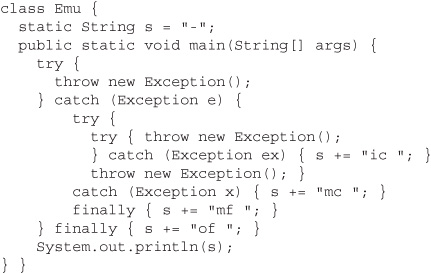
What is the result?
A. -ic of
B. -mf of
C. -mc mf
D. -ic mf of
E. -ic mc mf of
F. -ic mc of mf
G. Compilation fails
7. Given:
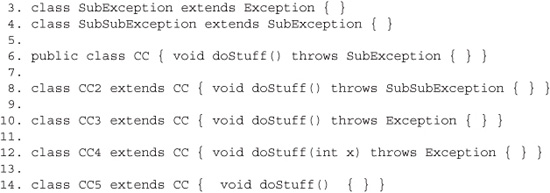
What is the result? (Choose all that apply.)
A. Compilation succeeds
B. Compilation fails due to an error on line 8
C. Compilation fails due to an error on line 10
D. Compilation fails due to an error on line 12
E. Compilation fails due to an error on line 14
8. Given:
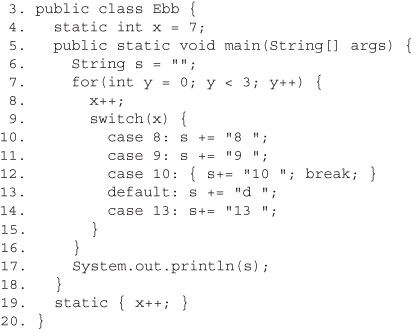
A. 9 10 d
B. 8 9 10 d
C. 9 10 10 d
D. 9 10 10 d 13
E. 8 9 10 10 d 13
F. 8 9 10 9 10 10 d 13
G. Compilation fails
9. Given:
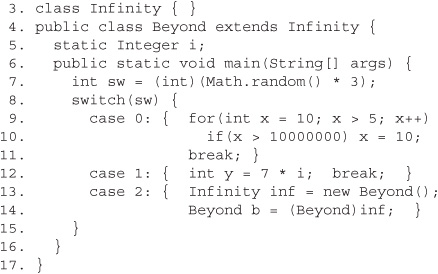
And given that line 7 will assign the value 0, 1, or 2 to sw, which are true? (Choose all that apply.)
A. Compilation fails
B. A ClassCastException might be thrown
C. A StackOverflowError might be thrown
D. A NullPointerException might be thrown
E. An IllegalStateException might be thrown
F. The program might hang without ever completing
G. The program will always complete without exception
10. Given:
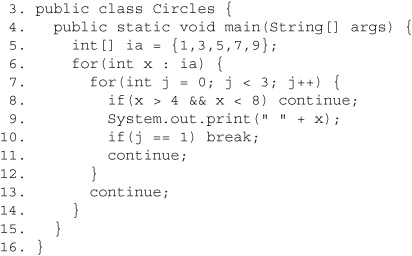
What is the result?
A. 1 3 9
B. 5 5 7 7
C. 1 3 3 9 9
D. 1 1 3 3 9 9
E. 1 1 1 3 3 3 9 9 9
F. Compilation fails
11. Given:
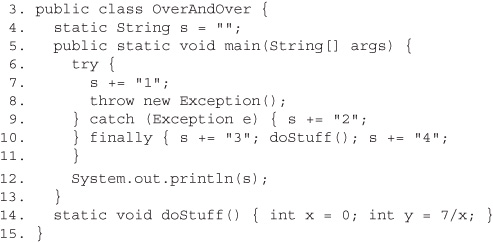
A. 12
B. 13
C. 123
D. 1234
E. Compilation fails
F. 123 followed by an exception
G. 1234 followed by an exception
H. An exception is thrown with no other output
12. Given:
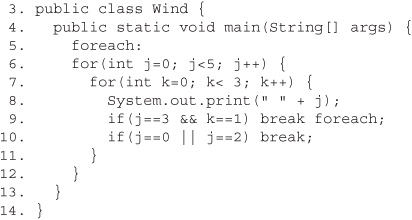
What is the result?
A. 0 1 2 3
B. 1 1 1 3 3
C. 0 1 1 1 2 3 3
D. 1 1 1 3 3 4 4 4
E. 0 1 1 1 2 3 3 4 4 4
F. Compilation fails
13. Given:
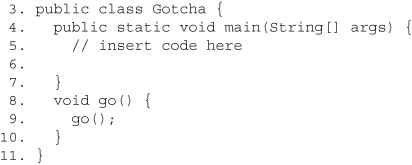
And given the following three code fragments:

When fragments I - III are added, independently, at line 5, which are true? (Choose all that apply.)
A. Some will not compile
B. They will all compile
C. All will complete normally
D. None will complete normally
E. Only one will complete normally
F. Two of them will complete normally
14. Given:

Which are true? (Choose all that apply.)
A. Compilation succeeds
B. Compilation fails due to an error on line 6
C. Compilation fails due to an error on line 7
D. Compilation fails due to an error on line 8
E. Compilation fails due to an error on line 9
F. Compilation fails due to an error on line 10
15. Given:
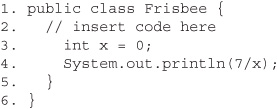
And given the following four code fragments:

If the four fragments are inserted independently at line 4, which are true? (Choose all that apply.)
A. All four will compile and execute without exception
B. All four will compile and execute and throw an exception
C. Some, but not all, will compile and execute without exception
D. Some, but not all, will compile and execute and throw an exception
E. When considering fragments II, III, and IV, of those that will compile, adding a try/catch block around line 6 will cause compilation to fail
16. Given:
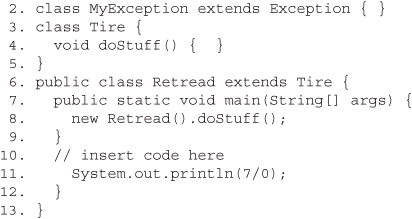
And given the following four code fragments:

When fragments I - IV are added, independently, at line 10, which are true? (Choose all that apply.)
A. None will compile
B. They will all compile
C. Some, but not all, will compile
D. All of those that compile will throw an exception at runtime
E. None of those that compile will throw an exception at runtime
F. Only some of those that compile will throw an exception at runtime
SELF TEST ANSWERS
1. Given two files:
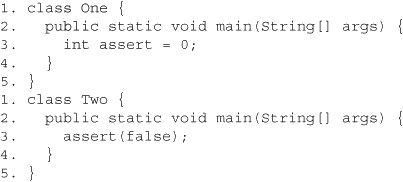
And the four command-line invocations:

What is the result? (Choose all that apply.)
A. Only one compilation will succeed
B. Exactly two compilations will succeed
C. Exactly three compilations will succeed
D. All four compilations will succeed
E. No compiler warnings will be produced
F. At least one compiler warning will be produced
Answer: |
|
|
|
|
2. Given:
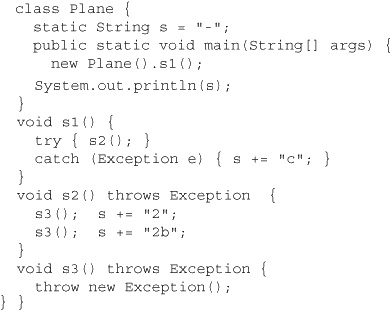
A. -
B. -c
C. -c2
D. -2c
E. -c22b
F. -2c2b
G. -2c2bc
H. Compilation fails
Answer: |
|
|
|
|
3. Given:
![]()
Which could be used to create an appropriate catch block? (Choose all that apply.)
A. ClassCastException
B. IllegalStateException
C. NumberFormatException
D. IllegalArgumentException
E. ExceptionInInitializerError
F. ArrayIndexOutOfBoundsException
Answer: |
|
|
|
|
4. Which are true? (Choose all that apply.)
A. It is appropriate to use assertions to validate arguments to methods marked public
B. It is appropriate to catch and handle assertion errors
C. It is NOT appropriate to use assertions to validate command-line arguments
D. It is appropriate to use assertions to generate alerts when you reach code that should not be reachable
E. It is NOT appropriate for assertions to change a program's state
Answer: |
|
|
|
|
5. Given:

Which, inserted independently at line 4, compiles? (Choose all that apply.)
A. for(int y : x) {
B. for(x : int y) {
C. int y = 0; for(y : x) {
D. for(int y=0, z=0; z<x.length; z++) { y = x[z];
E. for(int y=0, int z=0; z<x.length; z++) { y = x[z];
F. int y = 0; for(int z=0; z<x.length; z++) { y = x[z];
Answer: |
|
|
|
|
6. Given:

What is the result?
A. -ic of
B. -mf of
C. -mc mf
D. -ic mf of
E. -ic mc mf of
F. -ic mc of mf
G. Compilation fails
